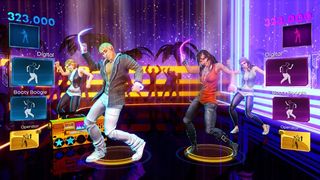
You mentioned you’re implementing a lower difficulty level, reducing that barrier of entry and getting people accustomed to the nature of the gameplay. Tell us about the challenge, though, of making flash cards for every different routine and making those motions readable in the second they’re on the screen.
Right from the start, we shot way too high with the difficulty. The first song we made, we put it in front our CEO and VP of product development, and they were like “we can’t evaluate the game yet, we can’t do these dance moves”. That sent us back to the drawing board a little bit - we knew it was a little bit too hard in our minds, but we didn’t think it was that hard. The group of people working on the choreography had been in dance lessons and in the world of dance for quite a while, so we went back to it, trying to make Easy easy. We ended up bringing a whole bunch of our employees, many who were working on Rock Band 3 at the time and were self identified as “horrible dancers”, to the place where we were doing our dance classes, and had our choreographers go through a series of moves that myself and a couple of people on the choreography team agree were the core of the routines that we’ve created.
We videotaped the whole thing, and had the choreographers dancing in the same way that the characters do on screen, and noted what type of things people had problems with, what type of movements and rhythms were difficult for people, and from there we sort of developed a good lexicon for what each difficulty was. I wrote up something called the “Dance Central Choreography Guidelines”, which have been revised several times since then, most recently to include this Beginner difficulty concept, but within that are internal learnings about what things are easily accessible to people, and what order of movements you should stack on top of each other. For example, the first routine you encounter in Dance Central, “Poker Face”, has a pretty distinct choreographic layout - you’re usually starting a movement with your legs, then a few bars later you’re moving your hands. As we were developing that structure, we tried to put that in as many places as we could throughout all the songs in Dance Central.

At the same time, we were working on the flashcard language. That was something I had developed initially with a very small group of people in a prototype that eventually became Dance Central - this was before we were ever in production with the game, before we were working with Kinect. In that, we had decided that the point of flashcards was twofold: to give people a hint of the type of movement they were doing, and most importantly show them the move they were going to do first and what the direction was, and ideally the limb it was going to be on. The limb highlighting happens within the flash cards, and with the placement of arrows or movement lines show people what they’re going to do first. We also needed to make the movement images memorable in their own right, so they can aid with muscle memory to people who are more visually focused. And then we named every move to get people to find a more thematic concept to associate with each move, because a fair amount of what we think is choreographed dance is the feeling of having mastered it.
We shot way too high with the difficulty. The first song we made, we put it in front our CEO and VP, and they were like "we can't evaluate the game yet, we can’t do these dance moves"
With Dance Central 2 and the Break It Down mode, the idea was to try and break down those barriers of memorisation and allow people to jump into the flow of dance and the flow of choreography that much quicker, and make the experience of dancing that much more satisfying. We did a fair amount of reading into learning styles to figure out the best way to design these things so that, when people get comfortable with the flash card language, they can jump right in and feel like they’ve mastered a routine way before they’ve actually memorised it, and we feel like it’s been a great success in that right.
But the addition of Beginner mode is, as you’ve said, a way to get people comfortable with the interface itself. The first thing people see is the character, quite obviously, then they’ll start to notice what we call the prelim feedback - the red outlines that happen when you aren’t moving a particular limb correctly, then they’ll notice the spotlight, then the flash cards, then the boom box with the stars on it, and then their score. There’s a sort of a camera aperture opening up within the person’s point of view of the game, and flash cards aren’t the first thing - they’re always looking at the character first. Give them dance moves that allow them to get comfortable and feel like they’ve mastered that move, and they’ll start to look around and get familiar with the rest of the interface. It’s always important for us to be working on accessible content for first time players, and a party for us is a scenario to potentially come upon tens of first time players. We want to make that experience as positive as possible.

Tell us how you’ve made the first time travel dancing game. How does that feature in the singleplayer campaign?
When we created this concept of time travel, it was really to reinforce these dance crazes in an appropriate context. There’s always been questions like “do we want to put the Hustle or the Macarena in this game?” and we’ve always had a focus on authenticity throughout the history of Harmonix games. Time travel, as silly as it sounds, became the most authentic way to present this content, so we can show you the Hustle in a disco-style roller rink in the 70s with characters in 70s garb. And then, from that initial impulse, we built the whole world around it: a Dance Central intelligence agency in charge of preventing dance crimes and the dance fascists who are trying to dominate and destroy creativity within Dance Central.
Time travel, as silly as it sounds, became the most authentic way to present this content
The genesis was from a choreographic and design standpoint, and we started liking it more and more as we started to build up a world around it. We also found great ways for our characters to reveal more about themselves throughout that narrative - having them stuck back in time in a particular era let us reveal that much more about them. What would they have done back then? What kind of person is Angel in the 70s? What sort of person is Glitch in the 80s? It tackles something a little bit different to what we’ve done with the crew challenge mode before. And, you know, it was just a good fit for the content, and a funny idea, and it allows us to make a lot of good jokes as well. If we’re going to make you dance in front of your television and be engaged in a story, we also want to make you laugh. So the notion of a time-travelling boom box and going back to learn these dance crazes did strike us as quite silly, but then we think that silly, fun, and lighthearted is appropriate for a dance game story.

Dance Central 3 is released on October 16 in the US, and October 19 in Europe and Australia

